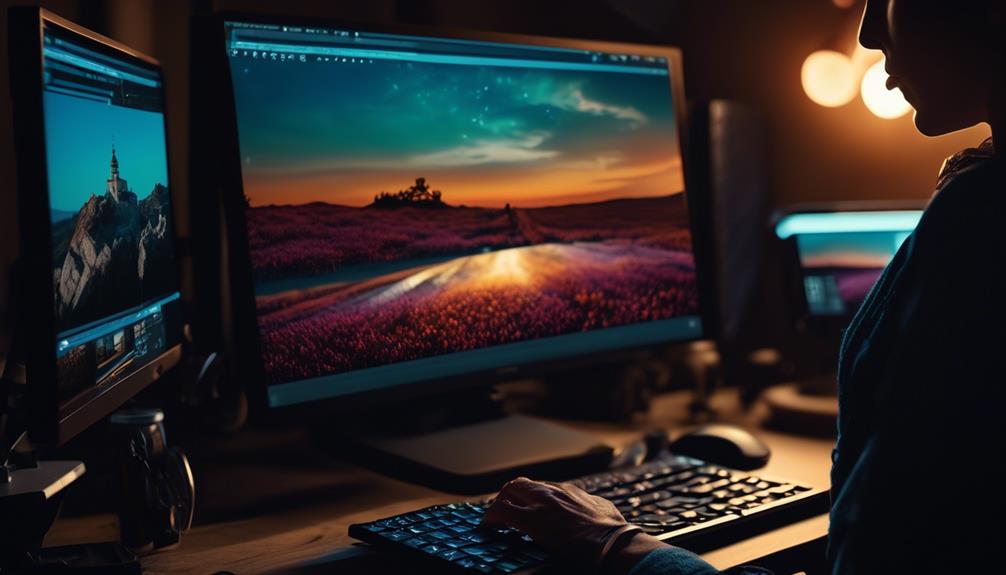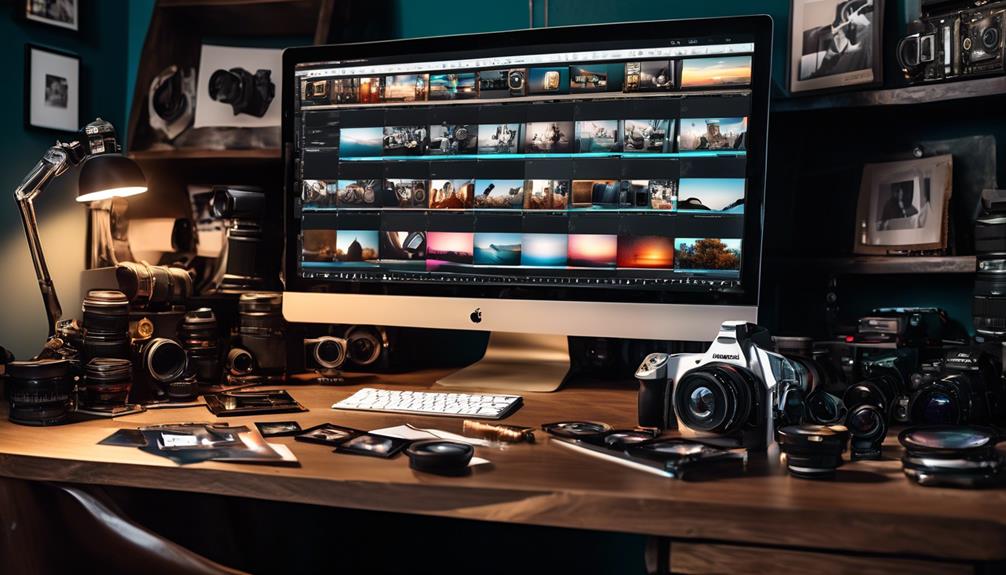Please note this post may contain affiliate links picked by me (Jay) that I have deemed may be of interest or relevant to you the reader of this.
These links do not affect the cost of the thing if you decide to purchase but i may get a little money if you choose to purchase.
For more information on my affiliate link policy click here.
As I stare at my collection of untouched photo edits, it's hard not to feel a sense of disappointment. I had hoped that these edits would magically elevate my photography, transforming my shots into masterpieces. But alas, they remain stagnant, lacking that wow factor I so desperately crave.
So, what's the missing ingredient? Why aren't my photo edits taking my photography to new heights? Well, my friend, buckle up because we're about to embark on a journey through the world of photo editing, uncovering the secrets that may just turn your ordinary shots into extraordinary works of art.
Key Takeaways
- Understanding the basics of photo editing is crucial for creating visually striking images.
- Choosing the right editing software can elevate your photography.
- Mastering the use of light and color enhances the mood and atmosphere of photos.
- Enhancing composition and cropping techniques draws the viewer's eye to the main subject.
Understanding the Basics of Photo Editing
When I first started diving into the world of photo editing, I quickly realized that understanding the basics was essential for taking my photography to the next level. It's not just about capturing a great shot; it's about bringing that shot to life through the editing process.
Understanding the importance of post-processing and exploring different editing styles can truly elevate your photography and set it apart from the rest.
Post-processing, or photo editing, is the stage where you can enhance and refine your images. It allows you to adjust exposure, color balance, and sharpness, among other things. This step is crucial because it gives you the opportunity to bring out the true potential of your photos. By understanding the importance of post-processing, you can create images that are visually striking and evoke emotions in your viewers.
Exploring different editing styles is another key aspect of photo editing. Each style has its own unique characteristics and can greatly impact the overall mood and feel of your images. Whether you prefer a clean and minimalistic look or a bold and vibrant aesthetic, experimenting with different editing styles can help you develop your own signature style. It's about finding what resonates with you and what best complements the subject matter of your photos.
Understanding the basics of photo editing isn't only about technical skills; it's also about developing your artistic eye. It's about understanding how different editing techniques can enhance your images and communicate your intended message. By investing time and effort into learning the basics, you'll be able to create images that truly stand out and captivate your audience.
Choosing the Right Editing Software
To elevate your photography through post-processing, one of the most important decisions you'll make is choosing the right editing software. With so many options available, it can be overwhelming to determine which one is best for you. However, by understanding the differentiating between editing and retouching techniques, as well as exploring the benefits of using presets and filters, you can make an informed decision that will take your photography to the next level.
When it comes to editing software, it's important to understand the distinction between editing and retouching. Editing involves adjusting basic elements such as exposure, contrast, and color balance to enhance the overall look of your photo. On the other hand, retouching involves more detailed work such as removing blemishes, smoothing skin, and altering specific areas of the image. Depending on your needs, you'll want to choose software that offers the tools and capabilities required for both editing and retouching.
Another valuable feature to consider when choosing editing software is the use of presets and filters. Presets are pre-determined settings that can be applied to your photo with a single click, instantly transforming the look and feel of the image. Filters, on the other hand, are like digital overlays that can add special effects or enhance specific colors in your photo. By utilizing presets and filters, you can save time and achieve consistent results across your photos.
Mastering the Use of Light and Color
For me, mastering the use of light and color is the key to creating captivating and visually appealing photographs. As a photographer, I constantly strive to manipulate shadows and highlights effectively to bring out the desired mood and atmosphere in my images.
Here are some techniques I've found to be particularly effective:
- Contrast Enhancement: Playing with shadows and highlights can add depth and dimension to your photos. By selectively darkening the shadows and brightening the highlights, you can create a more dynamic and visually striking image.
- Color Grading: Utilizing color grading techniques can greatly enhance the mood of your photographs. Whether it's warming up the colors to create a cozy and nostalgic feel or adding cooler tones for a more serene and tranquil atmosphere, color grading allows you to evoke specific emotions through the use of color.
- Selective Saturation: Adjusting the saturation levels of specific colors within an image can help draw attention to certain elements and create a more balanced and harmonious composition. By selectively desaturating or intensifying certain colors, you can guide the viewer's eye and create visual interest.
- White Balance Adjustment: Correcting the white balance of your images can have a significant impact on the overall tone and atmosphere. Whether you prefer a warm or cool look, adjusting the white balance ensures that the colors in your photograph appear as they were intended.
- Creative Use of Light: Experimenting with different lighting techniques can transform an ordinary scene into something extraordinary. Whether it's using natural light, artificial lighting, or even playing with shadows, finding unique and innovative ways to illuminate your subject can make your photographs truly stand out.
Enhancing Composition and Cropping Techniques
As a photographer, I have discovered that enhancing composition and utilizing effective cropping techniques can take your photographs to the next level, elevating the overall impact and visual storytelling of your images. By implementing the rule of thirds and leading lines, you can create dynamic and visually appealing compositions that draw the viewer's eye to the main subject.
The rule of thirds involves dividing your frame into a 3×3 grid and placing your subject along the intersecting lines. This technique adds balance and interest to your images, making them more visually pleasing. Leading lines, on the other hand, are lines within the frame that guide the viewer's gaze towards the subject, creating a sense of depth and movement. Incorporating leading lines can enhance the composition and create a stronger visual narrative.
Another important aspect of composition is framing and perspective. Framing refers to using elements within the frame, such as archways or trees, to create a natural frame around your subject. This technique adds depth and context to your images, making them more engaging. Perspective, on the other hand, involves changing your angle or viewpoint to create a unique and interesting composition. By experimenting with different perspectives, you can capture images from a fresh and innovative point of view.
To further illustrate the importance of enhancing composition and cropping techniques, take a look at the table below:
| Before | After |
|---|---|
|  |  |
| The subject is centered, resulting in a static composition. | The subject is placed along the rule of thirds, creating a more dynamic composition. |
|  |  |
| The leading lines are not utilized, making the image less engaging. | The leading lines guide the viewer's gaze towards the subject, creating a stronger visual impact. |
Exploring Advanced Editing Techniques
I have delved into the world of advanced editing techniques, discovering new ways to enhance my photographs and bring out their full potential. In my quest for innovation, I've come across some incredible tools and methods that have truly elevated my photography.
Here are a few of the advanced editing techniques that have transformed my images:
- Creative filters: By applying creative filters, I can add unique effects to my photos, such as vintage, black and white, or even dreamy light leaks. These filters bring a new dimension to my images, allowing me to experiment with different moods and styles.
- Advanced retouching techniques: With advanced retouching techniques, I can take my editing skills to the next level. From seamlessly removing blemishes and imperfections to enhancing skin tones and textures, these techniques allow me to create flawless portraits that truly stand out.
- Dodge and burn: This technique involves selectively brightening and darkening specific areas of an image. By using this method, I can add depth, dimension, and drama to my photographs, bringing out the finer details and creating a more captivating visual experience.
- Color grading: Color grading is a powerful editing technique that allows me to manipulate the colors in my photographs to create a specific mood or atmosphere. Whether it's giving my images a warm and nostalgic feel or a cool and modern vibe, color grading adds a unique touch to my photos.
- Composite photography: With composite photography, I can merge multiple images together to create a completely new and imaginative composition. This technique opens up endless possibilities for storytelling and allows me to create images that go beyond the boundaries of reality.
Frequently Asked Questions
How Can I Improve the Clarity and Sharpness of My Photos Through Editing?
To improve the clarity and sharpness of your photos through editing, there are a few techniques that can make a big difference.
First, try adjusting the contrast and brightness to enhance image clarity.
Secondly, sharpening tools can be used to improve the sharpness of details in your photos.
Lastly, paying attention to the resolution and size of your images can also contribute to a clearer and sharper final result.
Experiment with these techniques and watch your photography elevate to the next level.
Are There Any Free Editing Software Options That Are Recommended for Beginners?
I've tried a few free editing software options as a beginner, and one that I found really useful was Snapseed.
It's a smartphone app that offers a range of editing tools and filters.
One advantage is its user-friendly interface, making it easy to navigate and experiment with different edits.
However, a disadvantage is that it may not have all the advanced features that professional software offers.
What Are Some Common Mistakes to Avoid When Adjusting Light and Color in My Photos?
When it comes to adjusting light and color in my photos, there are a few common mistakes that I've learned to avoid.
First, it's important not to overdo it with exposure. Finding the right balance is key to creating a natural-looking image.
Second, be cautious with saturation. While it can add vibrancy, too much can make the photo look unnatural.
How Can I Effectively Use Cropping Techniques to Enhance the Composition of My Photos?
When it comes to enhancing the composition of my photos, cropping techniques have been a game-changer for me.
Knowing when and how to use them effectively can really elevate the overall look and feel of my images.
By carefully cropping out distracting elements and focusing on the main subject, I'm able to create a more balanced composition that draws viewers in.
It's a simple yet powerful tool that adds that extra touch of innovation to my photography.
What Are Some Advanced Editing Techniques That Can Take My Photos to the Next Level?
When it comes to enhancing photo composition, advanced editing techniques can truly take your photos to the next level.
By exploring tools like layer masks, dodge and burn, and selective color adjustments, you can bring out the best in your images.
These techniques allow you to fine-tune the details, create depth and dimension, and even transform the mood of your photos.
It's amazing how a few tweaks in editing can elevate your photography and give it that extra wow factor.
Conclusion
In conclusion, mastering the art of photo editing is essential for taking your photography to the next level. It's not just about making your images look better, but also about enhancing the storytelling aspect of your work.
While some may argue that editing takes away from the authenticity of a photograph, remember that it's a tool that allows you to express your artistic vision and create captivating visuals.
So, don't be afraid to experiment and push the boundaries of what's possible with photo editing.


